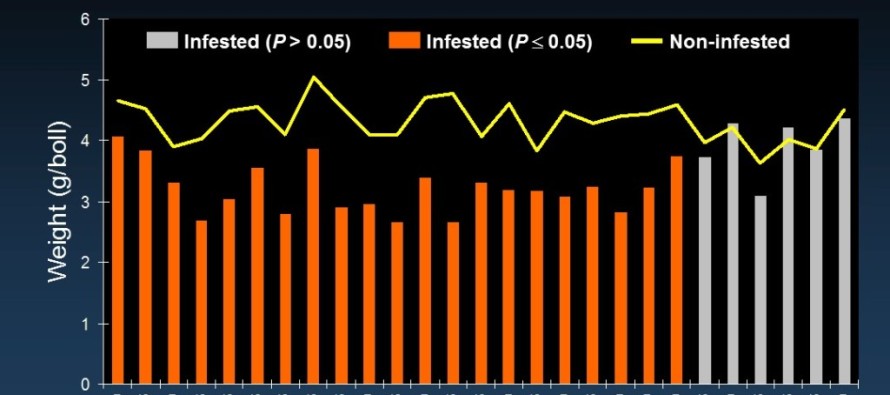When to Terminate Bollworm Sprays in Late Season Bt Cotton

We have had numerous calls over the last couple weeks about small, 2-5 day old larvae, under bloom tags in Bt cotton that is near, at, or beyond cutout. All of the research done to this point suggests that cotton is safe from bollworm damage when it reaches node above white flower 5 plus 300 heat units.
We arrived at this point because we know, in most situations, the last harvestable boll will be the first position white flower on the 5th node below the terminal. We also know that bollworms are far less likely to damage a boll once it has accumulated at least 350 heat units originating from a hatch out larvae on a bloom tag. The figure below shows some research that I did in graduate school to determine when a boll is safe from bollworm injury. We tagged white flowers in NuCOTN 33B (one of the original Bollgard varieties) every day with the date it was a white flower. We came back at different points during the season and caged bollworm larvae on those bolls and calculated the number of heat units that it accumulated. After 3 days, we came back and looked at those bolls to see if they had shed or if they were damaged. If they did not shed, we tracked them throughout the rest of the season and hand harvested them once they opened. We also had uninfested bolls at each infestation timing to compare yields.
 The graph is showing the average yields of individual bolls that were infested (orange or gray bars) or not infested (yellow line). The orange bars indicate infested bolls where the weights were significantly lower than the uninfested bolls. The gray bars are where no differences were observed between the infested and uninfested bolls at each of those boll ages. As you can see, in the graph, bollworms no longer reduced yields of bolls that had accumulated about 300 heat units. As a conservative estimate, we suggest that bolls are safe when they have accumulated 350 heat units.
The graph is showing the average yields of individual bolls that were infested (orange or gray bars) or not infested (yellow line). The orange bars indicate infested bolls where the weights were significantly lower than the uninfested bolls. The gray bars are where no differences were observed between the infested and uninfested bolls at each of those boll ages. As you can see, in the graph, bollworms no longer reduced yields of bolls that had accumulated about 300 heat units. As a conservative estimate, we suggest that bolls are safe when they have accumulated 350 heat units.
Results on non-Bt cotton were very similar to these results, so they should also be applicable to any of the dual-gene Bt cottons currently available.
Based on this we suggest that once you start having white flowers on the top 1-3 nodes of a cotton plant, bollworms are not likely to reduce yields enough to justify spraying them. Especially in recent years where pyrethroids have not been providing acceptable control of bollworms. The insecticides that would need to be used to control bollworms include the diamides (like Prevathon, Besiege, or Belt) or one of the other true caterpillar products (like Radiant, Steward, etc.).
At this stage in the season, a few of those larvae may move down the plant and damage a few bolls near the top of the plant. However, the yield loss is still not great enough to justify a $10-20 per acre application. In most situations, if you are at a point where you feel the crop is safe from other pests such as plant bugs, the crop is going to also be safe from yield losses from bollworms, especially in the dual-gene Bt cottons.
There are a few pests like stink bugs that can still cause significant damage to cotton bolls beyond this point. If you are going across the field to spray stink bugs and you have bollworms under bloom tags in Bt cotton, then it is a good idea to tank mix a pyrethroid with an organophosphate. This will do a much better job on stink bugs, and although it will not completely control bollworms, the mixture of the 2 products will help to kill a few more bollworms than you would with a pyrethroid alone.
Finally, if you find yourself stressing about it too much and need some help, feel free to give any of us a call at any time.




Let me tell You a sad story ! There are no comments yet, but You can be first one to comment this article.
Write a comment